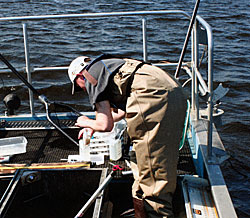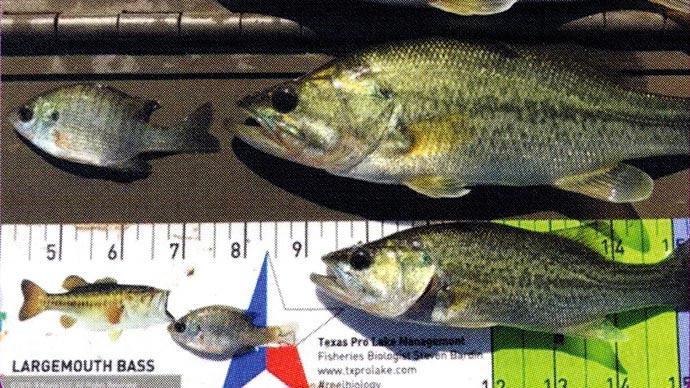
Dave Willis was a visionary who started a movement in fisheries science and education by building a bridge to the private sector. He did something I've never seen another fisheries professor do. Beyond one-way communication of science to the private sector, he brought the collective wisdom and experience of the private sector back into the classroom and research arenas. I'm grateful to have learned from Dave and to have the opportunity to build on this foundation under the theme of Science-based Management.
In the coming months and years, this column will have three main themes. First, northern pond management. As Dr. Willis taught us, these systems present some unique challenges, which we are currently working to overcome. Second, Grand Challenges in fisheries. This theme will span all of natural resource management—from pond owners to policy makers. The first challenge is aging reservoirs and habitat rehabilitation. This is one of our big research areas at South Dakota State University. Third, we will continue to highlight student projects. We have some great students working on projects that directly apply to pond owners.

Science-based management—using the best available science to shape our management, even when it calls us out of our comfort zone. It is similar to evidence-based medicine, or evidence-based management in the business world. It combines current science with common sense, to direct management actions. This is sometimes uncomfortable, because new science contradicts some of what we think we know. I have scratched my head several times when science and data point me in weird directions.
Science is a process. It is often messy, confusing, and full of caveats. It is usually far from black or white, often shades of grey. We will work hard to sort through the clutter, identify assumptions, and provide information to be successful.
Habitat management has long been a pillar of fisheries management. We routinely adjust water quality and depth, we add substrate for spawning, we manage vegetation for young fish, and we add brush piles and artificial structure. So, how did this become a Grand Challenge? Old reservoirs. Most impoundments (including many of your ponds) are 40-60 years old. As reservoirs age, they lose structure such as timber, become filled in with sediment, and eventually become less productive for some of our favorite sport fish. Unfortunately, like the grey in my beard, aging reservoirs crept up on us, and when we started identifying the problem we realized a lot of damage has already been done, and we faced an uphill battle. A great analogy comes from Jeff Boxrucker, the current Director of the Reservoir Fisheries Habitat Partnership, who asked, "What other project would you build, leave unmaintained for 50-60 years, and expect to remain functional?"

We began researching habitat a couple of years ago. We are in year three of an intensive study spanning from South Dakota to Texas, examining the ecology of trophy fisheries. We are looking at everything from supplemental feeding (both the predators and the prey they eat), genetics, population dynamics (recruitment, growth, and mortality), movement patterns and activity levels, and habitat. This is a very impactful project with a large and ever growing list of collaborators partners. The original idea grew out of a project that Dave Willis, Bob Lusk, and I started in 2011 in Texas. The project has grown to include several others, including graduate students Jason Breeggemann and Chance Kirkeeng (you will hear more from them and in future columns), long time Pond Boss contributor Eric West, Pond Boss magazine subscriber Peter Maffei, state agency biologists, other pond owners, and industry partners. This project is funded primarily by a forward-thinking landowner, with additional support from SDSU, and of course the Pond Boss family and the Jesse West endowment.

Our focus on habitat is an example of the un-comfortable surprises of science-based management. Our main research lake in Texas is an old, 110-acre impoundment managed for largemouth bass. However, the lake was not consistently producing trophy bass, despite expert management. We researched largemouth bass ecology to figure out the problem. We estimated recruitment, growth, mortality, and abundance. Recruitment was consistent—no missing year classes. Growth was moderate to slow, and bass were living 8-10 years and dying of natural causes (the fishery was catch and release). You are probably thinking, 'aha! The bass are high density and need to be culled.' Nope, densities were moderate: 20-25 bass per hour of electrofishing, depending on the season. We estimated the population at 3,000- 3,500 bass over 10 inches, or 40-501bs pounds per acre of biomass. Genetics are mainly Florida so they had the potential to become trophies. We measured prey availability, there are bluegill, threadfin shad, gizzard shad, redear, and they were all moderate to very abundant. [Scratching our heads] Also, relative weights were variable. A few fish were plump (100+), but most were below what we expected (the population average was consistently in the mid-80's). Size structure, growth, and condition did not fit with our genetics and prey availability. [More head scratching] The data did not match what we thought we knew.
Our answer came unexpectedly from another part of the study: telemetry on 5-101b largemouth bass in the lake. We estimated seasonal movement, home range, activity level, and spawning sites of largemouth bass, and then we noticed a startling pattern. Based on the results of several previous studies, we expected bass to have a relatively small home range of perhaps 5-10 ac over the course of a year, with isolated larger movements. Indeed, a couple of tagged bass exhibited this pattern, and they just happened to be some of our fastest growing, and fattest. The majority of our bass had much larger home ranges (up to 70 acres). Even more striking, was that the fish with large home ranges routinely moved up to a mile in a 24 hour period, and we had one bass move 2 miles in 24 hours (the lake is about a mile long so it made a round trip). Our largemouth bass were acting more similar to striped bass, or as Bob Lusk said we have a bunch of bass that decided to become marathoners. Certainly not a strategy that will help them grow large.
We looked at habitat and we quickly figured out that this lake suffers the same ills as most old reservoirs. There was almost no structure! Most of the timber had long since decayed. To confirm this, we mapped the bottom using side-scan sonar, and found less than 5% of the lake had any form of cover such as stumps, standing timber, and laydown logs. We followed the science and identified the problem—we needed a LOT of habitat. Brush piles, mostly native cedar, were added 5-7 years earlier, but those had deteriorated to the point we couldn't see them on the side-scan sonar.
The story of how we figured out how much habitat to add involves some collective brain power to chase some new ideas. But, that is a story for next time.
Pond management continues to evolve and the scientific community is paying attention. With more collaboration, research will continue to ask questions and do our part to help via science-based management strategies.
Reprinted with permission from Pond Boss Magazine



